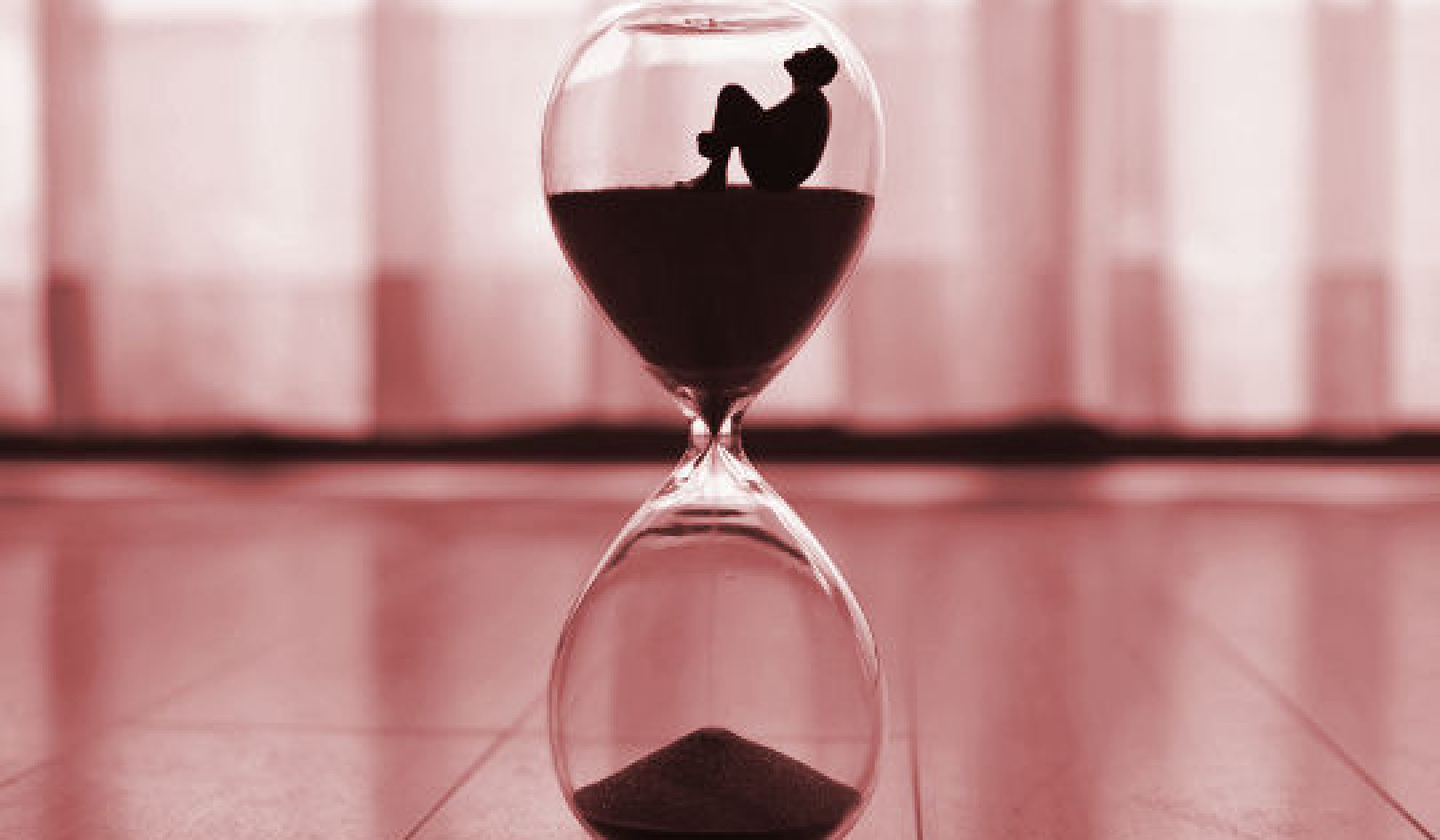During Saturn's first cycle, the major task is to find a place to stand in our lives and perceive a few reliable landmarks from which to take bearings, so that we can face life more than retreat from it. Then from 29-30 onward, we can begin to extend and deepen the various possibilities that our lives contain -- a process culminating in the second Saturn return at the age of 58-59. After this point of stock-taking, the third and final cycle begins. However, before being able to define clearly what the psychological changes and challenges of the three cycles are, it is necessary to define the essence of what the Saturn archetype brings into our personal lives.
Progressed Moon: The Rhythms of Life
I find it beautifully symbolic that the cycle of the progressed Moon runs closely with the Saturn cycle. The progressed Moon talks about our inextricable connection with the rhythms of life -- its cycles and its limits. It describes the necessity of separating out and moving on from one period of experience to another if we are to develop texture and complexity. But it also explains our drive to be safe and secure and to keep ourselves on familiar territory. The progressed Sun challenges the latter need, pushing us to differentiate, to take risks, to "follow our bliss".
The Saturn archetype, however, contains BOTH dimensions of this inner sol-lunar dynamic described by the progressed Sun and Moon, and it can be seen as their external worldly agent. Saturn as life's challenging, defining, and shaping principle clearly says to each newly born individual "Anything you can achieve in your life is confined by the inevitability of your mortality, and by the given described in your birth chart. In terms of complete Saturn cycles, you have three to work with at the most. Now get on with it -- see how far you can go!"
Saturn Challenge: Fully Become Who We Are & Can Be
At the start of life, all is potential. As the Saturn cycles unfold, they describe how that potential gradually crystallizes, concretizes, until by the end there is nothing left to develop in this lifetime. The challenges presented by Saturn have at their core the demand that we become who we are, and who we can be, as fully as possible, by separating from that which we are not and could never be.
There are important differences in the developmental demands of the stages symbolized by the three major cycles of Saturn. The first, from birth to ages 29-30, is the thesis stage. It is the most intensely physical, energetic, and least conscious cycle. It is about building the platform on which to stand in life. The second cycle, from 29-30 to 58-59 is the antithesis stage.
The initial structure is tested, challenged to grow; awareness and consciousness are more fully developed; life's goals are pursued and hopefully achieved to a sufficient degree in order to bring at least a tolerable level of satisfaction. In the synthesis stage, culminating at ages 87-88, ideally there is a bringing together and summing up of what one's life has meant, and a shifting of emphasis from worldly achievement to reflection and spiritual maturing. There is an acceptance of, and preparation for, the inevitable physical decline that ends in the death of the physical body.
I find the Saturn archetype profoundly paradoxical. On the one hand, Saturn represents that which nails us to the cross of matter, holding us in the world of form. On the other hand, when Saturn's challenges have been patiently and honestly worked with, and a mature realism arrived at, the sense of freedom of spirit that can then be released is immense -- full of the potential for satisfaction and joy. This sense of freedom is unconfined because it does not relate to matter at all. I am sure this is what the Buddhists mean when they talk about the "diamond soul".
First Saturn Return Cycle: Ages 29-30
We all arrive at the first Saturn return at the ages of 29-30. Whether we know we're having one or not, the broad determinants are the same. My metaphor for this return is the recollection I have of a science class, where I was fascinated to observe the growth of a copper sulfate crystal, which, over a period of weeks, emerged from clear blue water into a highly-defined, beautiful, crystalline shape.
At the first Saturn return, the crystalline shape that must emerge is that of realism. In a developmentally healthy person, the purity of that crystal of realism isn't overly tainted by bitterness, cynicism, and disillusion, all of which corrode the soul and limit the potential for further growth. As the crystal of realism emerges, it may well carry with it some pain, grief, and depression. This is healthy and normal enough as part of the process of getting through the 27-to-30-year period. We know from observation of the lives of others, and our own, that this period is critical.
To an astrologer's perception, its critical nature is emphasized by the knowledge that ages 27-30 brings with it four major symbolic patterns that are all about differentiation, individuation, and the facing and purging of illusions that hold us back from realization of our full potential. These patterns are: the second transit of the North Node to the natal South Node's position at age 27; the progressed Moon's return around age 27; transiting Pluto to natal Neptune between 27-29; and, of course, the Saturn return between ages 29-30, which seems to focus the other three patterns.
Saturn: Letting Go of Illusions & Defenses
Letting go of the illusions and defenses that buffer us from the poundings of life, but which also limit our becoming what we may most fully be, can be desperately painful. During this period, I was forced to give up my long cherished illusion of being a writer. It gave me a secret sense of superiority over the rest of the world and met my profound need to be special and different. When put to the test between ages 27-30, it crumbled. I realized that I had writing talent, for which I received some public recognition, but I also discovered that I lacked the single-minded drive that keeps one at it full-time. With out shedding my illusion and moving on, I would never have been able to develop my other gifts and talents, which began to take shape from my Saturn return onward.
The development of an internal locus of evaluation -- a sound sense of one's own worth that isn't overly dependent on the approval of parents, colleagues, partners, or peers -- is another psychological change that should be happening to a reasonably substantial degree by the Saturn return.
Saturn: Taking Responsibility For Our Actions
This marks the point in life where we are no longer seen as children or even very young adults by the larger world. We are expected to take responsibility for our own actions, and to be effective in the world as workers, partners, parents, and friends, with no excuses or allowances having to be made for our youth and immaturity.
Ideally, we should also have developed a sense of what the boundary is between our parents and ourselves -- between their demands of us and ours of them -- and how to respond to them in a mature fashion without falling prey to old, child-like patterns of behavior. If our parents haven't been mature enough to let go of us, we should be well on our way toward having the maturity to draw our own boundaries.
Saturn Rites of Passage
Although there is a common core to the rites of passage we all face, birth charts show that there are as many different Saturn returns as there are individuals. With Saturn in a fire sign, one's core challenge is to find faith in life, which, in turn, fuels the struggle to establish an unshakable sense of self-worth and of the special nature of one's contributions to the world. The Saturn-in-water person's major task is to come to terms with the inevitability that we are all separate and alone, no matter how much we may love other people or be loved by them. For Saturn in air, developing mental discipline, establishing intellectual credibility, and contributing worthwhile ideas to collective life are key formative tasks. The Saturn-in-earth person must form a sound relationship with the world of everyday reality, and pay the physical and material dimensions of life their due, in order to feel at peace within.
Each will have a different journey through the first formative Saturn cycle. The sign and house positions of Saturn, as well as whether it is angular or not, the Lunar Nodes, Chiron, and other planetary connections, provide the fine-tuning that shows the relationship between the archetypal forces present in all of life and the many differing ways they may manifest individually.
A Healthy First Saturn Return
Whether a person is functioning in a healthy way by the first Saturn return is dependent psychologically on how well he or she has negotiated the first three stages of the cycle. For example, those who have been unable to effectively separate from their mothers at the waxing square at ages 7-8 may still be locked into a dependent relationship at 29-30, and this will distort their development as the second cycle begins. Those without long-term partners, unable as yet to mature from the challenges of the first opposition at ages 14-15, may not see that being alone is better than being in an unfulfilling partnership, and are likely to carry some self-destructive relationship patterns into the next cycle. And finally, those who have failed to negotiate effective entry into the adult working world at the waning square of ages 21-22 are likely to have even more difficulty as their 30s advance, unless they can begin to see what self-defeating patterns are blocking their path.
Everyone has their distortions, their failures, their blindness. The gift of the first Saturn return is that the pressures it inevitably applies bring a great opportunity for us to look at those very aspects we have hitherto been unable to face. Saturn turns up the heat and pressure so much that the price of continued avoidance becomes higher than we are prepared to pay. Thus, realizing at a heart and soul level that "...the easiest path....is not the path of personal growth" has been the major turning point of many a life.
I find it very satisfying to work with clients who are either in the 27-to-30-year phase, or have been through the return and are taking stock at the beginning of the second cycle. It is here that the gifts of astrology are at their most potent, but only if people are willing to face who they are and be open to exploring some possible avenues of development that a good astrology reading can provide.
Clients who are strongly plugged into the energies symbolized by Uranus, Neptune, and Pluto can take a very long time to bring these connections into consciousness. The usual pattern is to be battered and buffeted by these forces right up until the age of 30 and beyond. It usually takes at least this long for such individuals to begin to comprehend their relationship with those great impersonal forces. Then they can consciously begin to align the personal with the impersonal in a more aware, less fearful, and, therefore, more creative way.
Until age 30, life's energy is waxing. The first Saturn return could be seen as the Full Moon point of life. Thereafter, the body starts to die, energy to wane, and our ability to recover from self-inflicted punishment and the battering of life begins to diminish. Consequently, the margin for serious errors to be made, from which one can recover and even benefit, grows inexorably narrower. The development of self-awareness becomes ever more important, as well as a realistic appreciation of both one's gifts and limitations.
Second Saturn Return Cycle: Ages 58-59
Saturn is the planet of strict justice. Blind, stubborn, arrogant, or fearful refusal to face certain basic realities in life, as the second cycle unfolds, skews the life path further and further away from who we could become were we able to acknowledge and accept who we actually are, rather than try to be who we are not. This brings increasing pain, dissatisfaction, emptiness, depression, and perhaps despair, as the second Saturn return approaches.
By the second Saturn return, we can see what our lives have become -- and we can see what it is too late to change. This is one of the most fundamental differences in perspective between the second and the first return. At age 30 we have probably still to sow the most productive seeds of our lives -- what we have already sown is still only germinating. But by the approach of 60, we are reaping the harvest and are confronted with the stark Biblical words, "As you sow, so shall you reap."
Facing the Final Cycle of Saturn
At one end of the spectrum are those who arrive at this stage feeling that their time on this Earth has not been wasted. They have very few regrets and are prepared to face the final cycle of life with equanimity, perhaps rooted in great spiritual depth. These people usually retain a zest for life and its remaining possibilities. At the other end are those who have sown meanly, poorly, or fearfully, and are reaping a harvest of regret, bitterness, loneliness, physical ill health, and fear of the waning of physical power and attractiveness in the inevitable decline toward death.
Most of us will arrive somewhere in the middle range, satisfied with some aspects of our achievement and disappointed by our areas of failure -- or those things that fate appears to have denied us without our having had much option for negotiation. I see the main challenges of this stage as follows: first, to value what we have been able to do; second, to come to terms with and accept those failures or disappointments that it is now too late to change; third, to find, within the limitations and constraints imposed by our state of mind, body, spirit, and bank balance, some further goals that are realistically achievable, which bring a sense of meaning and enjoyment to whatever time we have left.
To end on a personal note, I agree with Jung's dictum, and find it not morbid but full of wisdom, that a major task for the second half of life is preparation for the end of it. I intend to start to specifically, rather than tangentially, prepare for the end of my life by the time I get through the second Saturn return, if I live that long. Whether I will take it as far as the 16th century poet John Donne, who practiced for his death by lying in his coffin on a daily basis in the latter years of his life, I don't know. But with an exact Saturn/Pluto conjunction, also conjunct Mercury, Venus, the Moon, and the Sun, I can't pretend that the idea doesn't appeal to me!
©1998 Anne Whitaker - all rights reserved
 Recommended book:
Recommended book:
Saturn: A New Look At An Old Devil
by Liz Greene.
About The Author
 Anne Whitaker has a long background in adult education, social work, and counseling. Based in Glasgow, Scotland, she has practiced as an astrologer and astrology teacher since 1983, and a writer since 1992. Having recently gained her Diploma from the Centre for Psychological Astrology in London, co-directed by Dr Liz Greene and Charles Harvey, she is now a tutor there, as well as running the advertising side of Apollon, the new Journal of Psychological Astrology. Check out www.astrologer.com to access Metalog, which links to Apollon, to the Centre for Psychological Astrology, and to the Directory of Astrologers where Anne Whitaker (email
Anne Whitaker has a long background in adult education, social work, and counseling. Based in Glasgow, Scotland, she has practiced as an astrologer and astrology teacher since 1983, and a writer since 1992. Having recently gained her Diploma from the Centre for Psychological Astrology in London, co-directed by Dr Liz Greene and Charles Harvey, she is now a tutor there, as well as running the advertising side of Apollon, the new Journal of Psychological Astrology. Check out www.astrologer.com to access Metalog, which links to Apollon, to the Centre for Psychological Astrology, and to the Directory of Astrologers where Anne Whitaker (email
























